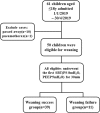The predictive value of diaphragm ultrasound for weaning outcomes in critically ill children
- PMID: 31888586
- PMCID: PMC6937936
- DOI: 10.1186/s12890-019-1034-0
The predictive value of diaphragm ultrasound for weaning outcomes in critically ill children
Abstract
Introduction: Multiple studies have shown that diaphragmatic ultrasound can better predict the outcome of weaning in adults. However, there are few studies focusing on children, leading to a lack of sufficient clinical evidence for the application of diaphragmatic ultrasound in children. The purpose of this study was to investigate the predictive value of diaphragm ultrasound for weaning outcomes in critically ill children.
Methods: The study included 50 cases whose mechanical ventilation (MV) time was > 48 h, and all eligibles were divided into either the weaning success group (n = 39) or the weaning failure group (n = 11). Diaphragm thickness, diaphragmatic excursion (DE), and diaphragmatic thickening fraction (DTF) were measured in the zone of apposition. The maximum inspiratory pressure (PImax) was also recorded.
Results: The ventilatory treatment time (P = 0.002) and length of PICU stay (P = 0.013) in the weaning failure group was longer than the success group. Cut-off values of diaphragmatic measures associated with successful weaning were ≥ 21% for DTF with a sensitivity of 0.82 and a specificity of 0.81, whereas it was ≥0.86 cm H2O/kg for PImax with a sensitivity of 0.51 and a specificity of 0.82. The linear correlation analysis showed that DTF had a significant positive correlation with PImax in children (P = 0.003).
Conclusions: Diaphragm ultrasound has potential value in predicting the weaning outcome of critically ill children. DTF and PImax presented better performance than other diaphragmatic parameters. However, DE has limited value in predicting weaning outcomes of children with MV.
Trial registration: Current Controlled Trials ChiCTR1800020196, (Dec 2018).
Keywords: Diaphragm; Mechanical ventilation; Paediatric; Pimax; Ultrasound; Weaning.
Conflict of interest statement
The authors declare that they have no competing interests.
Figures
Similar articles
-
Application of bedside ultrasound in predicting the outcome of weaning from mechanical ventilation in elderly patients.BMC Pulm Med. 2021 Jul 9;21(1):217. doi: 10.1186/s12890-021-01605-4. BMC Pulm Med. 2021. PMID: 34243739 Free PMC article.
-
[The predictive value of ultrasonic measurement of the diaphragmatic thickening fraction combined with the maximal inspiratory pressure in mechanical ventilation patients].Zhonghua Jie He He Hu Xi Za Zhi. 2020 Sep 12;43(9):778-783. doi: 10.3760/cma.j.cn112147-20200417-00513. Zhonghua Jie He He Hu Xi Za Zhi. 2020. PMID: 32894912 Chinese.
-
Ultrasound assessment of diaphragmatic dysfunction as a predictor of weaning outcome from mechanical ventilation: a systematic review and meta-analysis.BMJ Open. 2018 Oct 4;8(9):e021189. doi: 10.1136/bmjopen-2017-021189. BMJ Open. 2018. PMID: 30287605 Free PMC article.
-
[Predictive value of combined assessment of diaphragmatic and pulmonary ultrasound for weaning outcomes in mechanical ventilated patients with acute respiratory failure].Zhonghua Wei Zhong Bing Ji Jiu Yi Xue. 2022 Sep;34(9):941-946. doi: 10.3760/cma.j.cn121430-20220303-00200. Zhonghua Wei Zhong Bing Ji Jiu Yi Xue. 2022. PMID: 36377448 Chinese.
-
Accuracy of respiratory muscle assessments to predict weaning outcomes: a systematic review and comparative meta-analysis.Crit Care. 2024 Mar 7;28(1):70. doi: 10.1186/s13054-024-04823-4. Crit Care. 2024. PMID: 38454487 Free PMC article.
Cited by
-
Lung Ultrasound: Its Findings and New Applications in Neonatology and Pediatric Diseases.Diagnostics (Basel). 2021 Apr 3;11(4):652. doi: 10.3390/diagnostics11040652. Diagnostics (Basel). 2021. PMID: 33916882 Free PMC article. Review.
-
How to improve precision and reliability of diaphragm ultrasonographic measurements in newborns.Eur J Pediatr. 2021 Apr;180(4):1323-1324. doi: 10.1007/s00431-020-03873-4. Epub 2020 Nov 12. Eur J Pediatr. 2021. PMID: 33184729 No abstract available.
-
Roles of Lung Ultrasound Score in the Extubation Failure From Mechanical Ventilation Among Premature Infants With Neonatal Respiratory Distress Syndrome.Front Pediatr. 2021 Dec 6;9:709160. doi: 10.3389/fped.2021.709160. eCollection 2021. Front Pediatr. 2021. PMID: 34938695 Free PMC article.
-
Diaphragm muscle parameters as a predictive tool for weaning critically ill patients from mechanical ventilation: a systematic review and meta-analysis study.Eur J Transl Myol. 2024 Sep 3;34(3):12642. doi: 10.4081/ejtm.2024.12642. Eur J Transl Myol. 2024. PMID: 39228235 Free PMC article.
-
Advancements in imaging techniques for monitoring the respiratory muscles.Crit Care. 2025 Mar 12;29(1):110. doi: 10.1186/s13054-025-05339-1. Crit Care. 2025. PMID: 40075482 Free PMC article. Review.
References
MeSH terms
LinkOut - more resources
Full Text Sources
Research Materials





